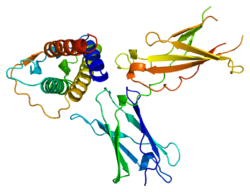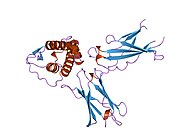Interleukin-4 receptor
| Interleukin-4 receptor alpha chain, N-terminal | |||||||||
|---|---|---|---|---|---|---|---|---|---|
 interleukin-4 / receptor alpha chain complex | |||||||||
| Identifiers | |||||||||
| Symbol | IL4Ra_N | ||||||||
| Pfam | PF09238 | ||||||||
| InterPro | IPR015319 | ||||||||
| SCOP2 | 1iar / SCOPe / SUPFAM | ||||||||
| |||||||||
The interleukin 4 receptor is a type I cytokine receptor. It is a heterodimer, that is, composed of two subunits. IL4R is the human gene coding for IL-4Rα, the subunit which combines with either common gamma chain (γc, forming the type I IL4 receptor) or with IL-13Rα1 (forming the type II IL4 receptor).[5]
Function
This gene encodes the alpha chain of the interleukin-4 receptor, a type I transmembrane protein that can bind interleukin 4 and interleukin 13 to regulate IgE antibody production in B cells. Among T cells, the encoded protein also can bind interleukin 4 to promote differentiation of Th2 cells. A soluble form of the encoded protein can be produced by an alternate splice variant or by proteolysis of the membrane-bound protein, and this soluble form can inhibit IL4-mediated cell proliferation and IL5 upregulation by T-cells. Allelic variations in this gene have been associated with atopy, a condition that can manifest itself as allergic rhinitis, sinusitis, asthma, or eczema. Two transcript variants encoding different isoforms, a membrane-bound and a soluble form, have been found for this gene.[6] Interactions of IL-4 with TNFα promote structural changes to vascular endothelial cells, thus playing an important role in tissue inflammation.[7]
The binding of IL-4 or IL-13 to the IL-4 receptor on the surface of macrophages results in the alternative activation of those macrophages. Alternatively activated macrophages (AAMΦ) downregulate inflammatory mediators such as IFNγ during immune responses, particularly with regards to helminth infections.[8]
Interactions
Interleukin-4 receptor has been shown to interact with SHC1.[9][10]
Structure
The N-terminal (extracellular) portion of interleukin-4 receptor is related in overall topology to fibronectin type III modules and folds into a sandwich comprising seven antiparallel beta sheets arranged in a three-strand and a four-strand beta-pleated sheet. They are required for binding of interleukin-4 to the receptor alpha chain, which is a crucial event for the generation of a Th2-dominated early immune response.[11]
See also
- Macrophage-activating factor
- Macrophage polarization
- Cluster of differentiation
- Fibronectin type III domain
References
- ^ a b c GRCh38: Ensembl release 89: ENSG00000077238 – Ensembl, May 2017
- ^ a b c GRCm38: Ensembl release 89: ENSMUSG00000030748 – Ensembl, May 2017
- ^ "Human PubMed Reference:". National Center for Biotechnology Information, U.S. National Library of Medicine.
- ^ "Mouse PubMed Reference:". National Center for Biotechnology Information, U.S. National Library of Medicine.
- ^ McCormick SM (14 July 2015). "Commentary: IL-4 and IL-13 receptors and signaling". Cytokine. 75 (1): 38–50. doi:10.1016/j.cyto.2015.05.023. PMC 4546937. PMID 26187331 – via Elsevier ScienceDirect.
- ^ "Entrez Gene: IL4R interleukin 4 receptor".
- ^ Thornhill MH, Wellicome SM, Mahiouz DL, Lanchbury J, Kyanaung U, Haskard DO (Jan 1991). "Tumor-necrosis-factor combines with IL-4 or IFN-gamma to selectively enhance endothelial-cell adhesiveness for T-cells-the contribution of vascular cell-adhesion molecule-1-dependent and molecule-1-independent binding mechanisms". Journal of Immunology. 146 (2): 592–598. doi:10.4049/jimmunol.146.2.592. PMID 1702807.
- ^ Tundup S, Srivastava L, Harn DA (April 2012). "Polarization of host immune responses by helminth-expressed glycans". Ann. N. Y. Acad. Sci. 1253 (1): E1–E13. Bibcode:2012NYASA1253E...1T. doi:10.1111/j.1749-6632.2012.06618.x. PMID 22974465. S2CID 43256244.
- ^ Ikizawa K, Yanagihara Y (February 2000). "Possible involvement of Shc in IL-4-induced germline epsilon transcription in a human B cell line". Biochem. Biophys. Res. Commun. 268 (1): 54–9. doi:10.1006/bbrc.2000.2080. PMID 10652211.
- ^ Kashiwada M, Giallourakis CC, Pan PY, Rothman PB (December 2001). "Immunoreceptor tyrosine-based inhibitory motif of the IL-4 receptor associates with SH2-containing phosphatases and regulates IL-4-induced proliferation". J. Immunol. 167 (11): 6382–7. doi:10.4049/jimmunol.167.11.6382. PMID 11714803.
- ^ Hage T, Sebald W, Reinemer P (April 1999). "Crystal structure of the interleukin-4/receptor alpha chain complex reveals a mosaic binding interface". Cell. 97 (2): 271–81. doi:10.1016/S0092-8674(00)80736-9. PMID 10219247. S2CID 18795930.
Further reading
- Nelms K, Keegan AD, Zamorano J, Ryan JJ, Paul WE (1999). "The IL-4 receptor: signaling mechanisms and biologic functions". Annu. Rev. Immunol. 17 (1): 701–38. doi:10.1146/annurev.immunol.17.1.701. PMID 10358772.
- Jiang H, Harris MB, Rothman P (2000). "IL-4/IL-13 signaling beyond JAK/STAT". J. Allergy Clin. Immunol. 105 (6 Pt 1): 1063–70. doi:10.1067/mai.2000.107604. PMID 10856136.
External links
- CD124+Antigen at the U.S. National Library of Medicine Medical Subject Headings (MeSH)
- PDBe-KB provides an overview of all the structure information available in the PDB for Human Interleukin-4 receptor subunit alpha






